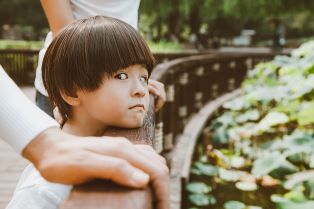Going Out to Dinner with Kids While on a Sleep Schedule
Separation Anxiety: Solutions for Peaceful Transitions
Separation anxiety can pop up at surprising times and in unexpected ways, and it often looks vastly different child to child. Understanding why childhood separation anxiety occurs and making a plan for how to deal with it can help your child navigate this developmental milestone.
What is Separation Anxiety?

For babies, separation anxiety is a result of the development of object permanence. This is when your child realizes that you still exist even when they can’t see you. This is why the game of peek-a-boo is so delightful for babies! Prior to this, your baby didn’t have this level of understanding. Experiencing this realization and coping with you being gone is a new experience! It can be hard on parents too, but you should know that separation anxiety is entirely normal. In fact, the presence of some anxiety around separating indicates a sign of meaningful attachment. That doesn’t mean if your child isn’t crying when you leave, that you are not healthily attached. It can show up at different ages and stages, and last a long time or a very short time.
What Age Do Children Typically Experience Separation Anxiety?
Some babies may understand object permanence (and thus show signs of separation anxiety) as early as 5 months. More commonly – or at least more noticeably – it pops in around 9 months and beyond. It tends to peak around the first birthday. Even infants who may not display much separation anxiety in infancy can experience it in toddlerhood. It is often very evident between 14 and 20 months. Toddlers’ awareness of times of separation grows as they get older. Thus, behaviors can become more drastic at transition times.
What Are Tips for Coping with Separation Anxiety?
While children have always experienced separation anxiety, the Covid lockdowns created additional challenges for young children. When the world began to re-open, it was apparent that children had a more difficult time adapting to separations after being home with just their immediate family for so long. Being around other people and in new places again was a big change for all of us. No matter when or how signs of separation anxiety may exhibit, there are a few ways to help little ones through it. Allow us to share some ways you can help your child navigate separation anxiety.
1. Foster Independent Play
Your little one follows your cues. If you’re not willing to let her out of your sight, she probably — albeit subconsciously — feels like she is not safe when you’re not in the room. Thus, designate a room where your children can explore a little and play without direct, constant supervision. It’s a small adjustment, but it has a tremendous effect. We aren’t talking about hours at a time. Rather, in small increments each day, when your infants or toddlers can be in a safe space independently, allow them to become familiar with being without a parent’s presence. Check out our blog dedicated to independent play to learn more.
2. Talk About It
Learning about separation (and reunion) is an important step, so that your child can feel secure that when you leave, you will come back. It may be tempting to sneak out, but it is important not to! Separation anxiety can be exacerbated if your child thinks you may be gone at any moment. When it is time to go separate ways for a short time or for the whole day, talk about it. Let them know that it’s okay for them to feel nervous when you leave, and reassure them that you’ll always come back. I’ve been known to sing the little Daniel Tiger jingle with my boys; “Grown-ups come back!” If there are some tears around the idea, allow your little one to express those feelings. This is an important conversation, and it will serve them well to be familiar with the idea.
3. Set Them Up for Separation Success
If a babysitter or relative is babysitting, try not to rush out as soon as they arrive. Spend a short time being altogether. This shows your child that you are comfortable with the person responsible for their care when you aren’t around. If you stay home with your child, choosing someone familiar to care for them in your absence can be good practice for them. If your child is older, ask them for a choice of game they want to play or book they want to read with the caregiver. This gives them some choice and allows them to engage in an activity when it’s time for you to leave. It can also help if you leave for short amounts of time initially. This will help to reinforce the idea that when you leave, you return.
If leaving is a routine part of your week, such as daycare, you likely won’t be able to hang around or just leave for a short amount of time. In this case, have a clear, consistent, concise routine in place. Predictability for a child experiencing separation anxiety most helpful. In those situations, repeat a short, attentive goodbye ritual to comfort and reassure the child each day. Do NOT change course because of a child’s reaction to your impending absence. Follow-through, especially in terms of coming back when you say you will. Consistency allows this process to improve, without increasing anxiety, for children. Children build security through our calm and repetitive responses. This is true when leaving a child at daycare and true at bedtime.
4. Avoid Avoidance
As I mentioned above, it can be so tempting to try to avoid triggering separation anxiety. Sneaking off, not going out, going out only after your child has gone to bed, even skipping school or daycare: These may all seem like good ideas in the short-term, however, they prevent an opportunity for clear communication around your coming and going, and missing school or daycare isn’t a strategy that will work long-term. Most importantly (and especially as children get older) it is important for us to help our children’s learn how to cope with anxiety. If we avoid all opportunity for them to practice separating and returning, it robs them of the chance to practice this skill. We want our kids to learn that when we leave, we also come back, reducing the uncertainty around the separation.
Speaking of coming back, if your child is cognitively aware enough to understand various parts of the day, instead of telling them how long you’ll be gone, focus on when you’ll be back. Use words that relate to their schedule (i.e. Mommy will be back at nap time, after dinner, before bath time, or so on).
5. One More Thing Before You Go

When children are hungry, tired, or not feeling well, separation anxiety tends to be heightened. Toddlers especially will be louder, more tearful, and more challenging to calm if they’re not feeling their best. Making sure your child will be well-fed, rested, and healthy, will help them to cope with your separation. It can also help to convey your child’s typical routine and needs to the caregiver, so their needs are met while you are gone in a way they are familiar with.
6. It’s Temporary
It can be hard to imagine while you’re in the throws of separation anxiety with your child, but it is rare for separation anxiety to persist on a daily basis beyond the preschool years. This is a skill that can take some practice, but you will be glad you did! Once a child has adjusted to an established place and a consistent routine, drop-offs become the norm. If your little one is not showing progress in adapting to familiar environments, use your pediatrician as a resource.
Your consistent and calm reassurance during these trying times will help your child navigate separation anxiety more easily. There are times for all humans, even as adults, when separating from someone or something familiar can bring up feelings of worry or anxiety. Think of moving to a new house or new town away from current family/friends, starting a new job, graduating to move on to the next stage of life, etc. The point is that feelings of unease come and go, and the same will be true for our kids. Sometimes, even good, comforting things have to end (albeit often temporarily for our children since we will be back in a matter of hours). Thankfully, there are great things to be experienced in those times too.


